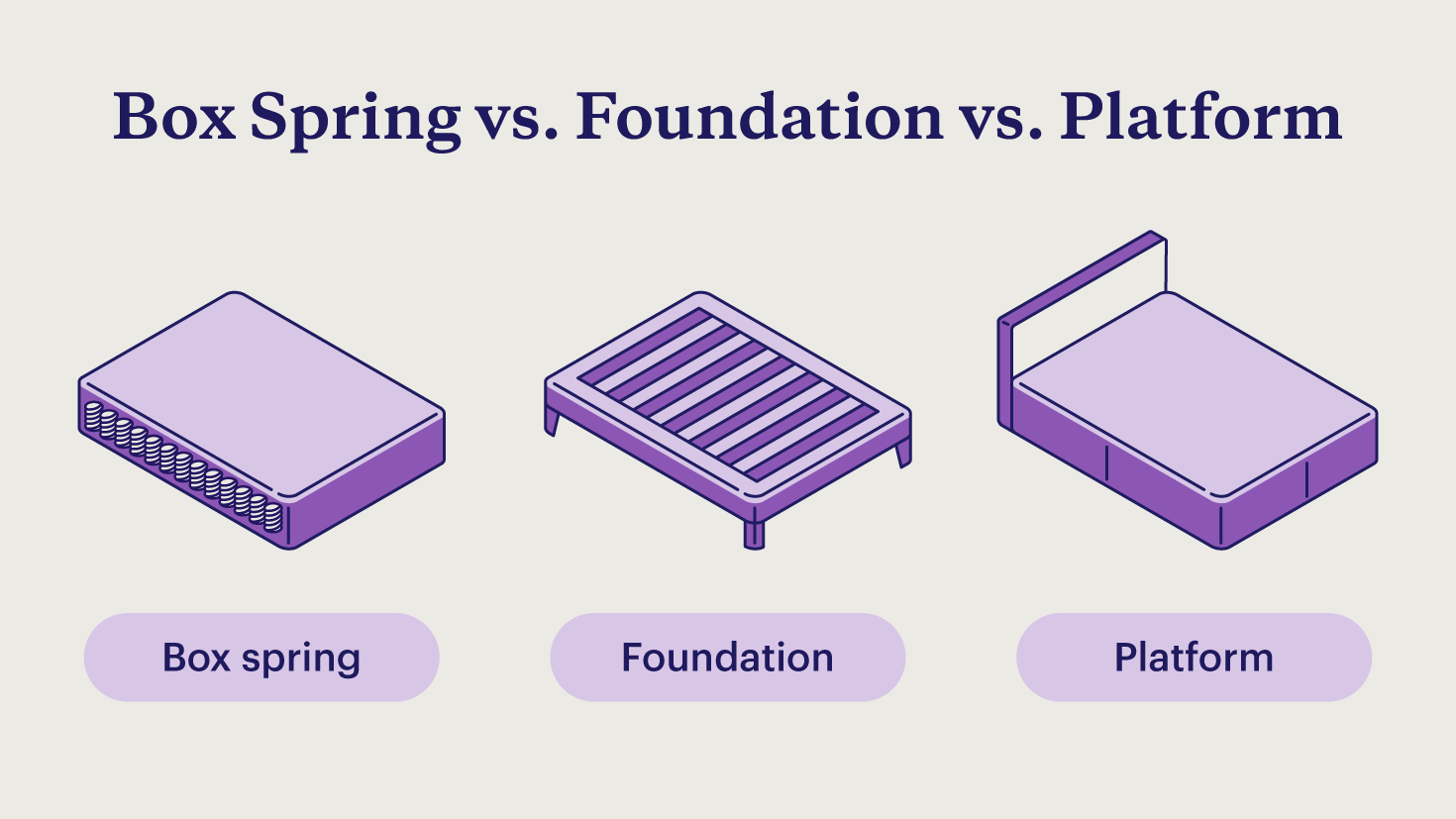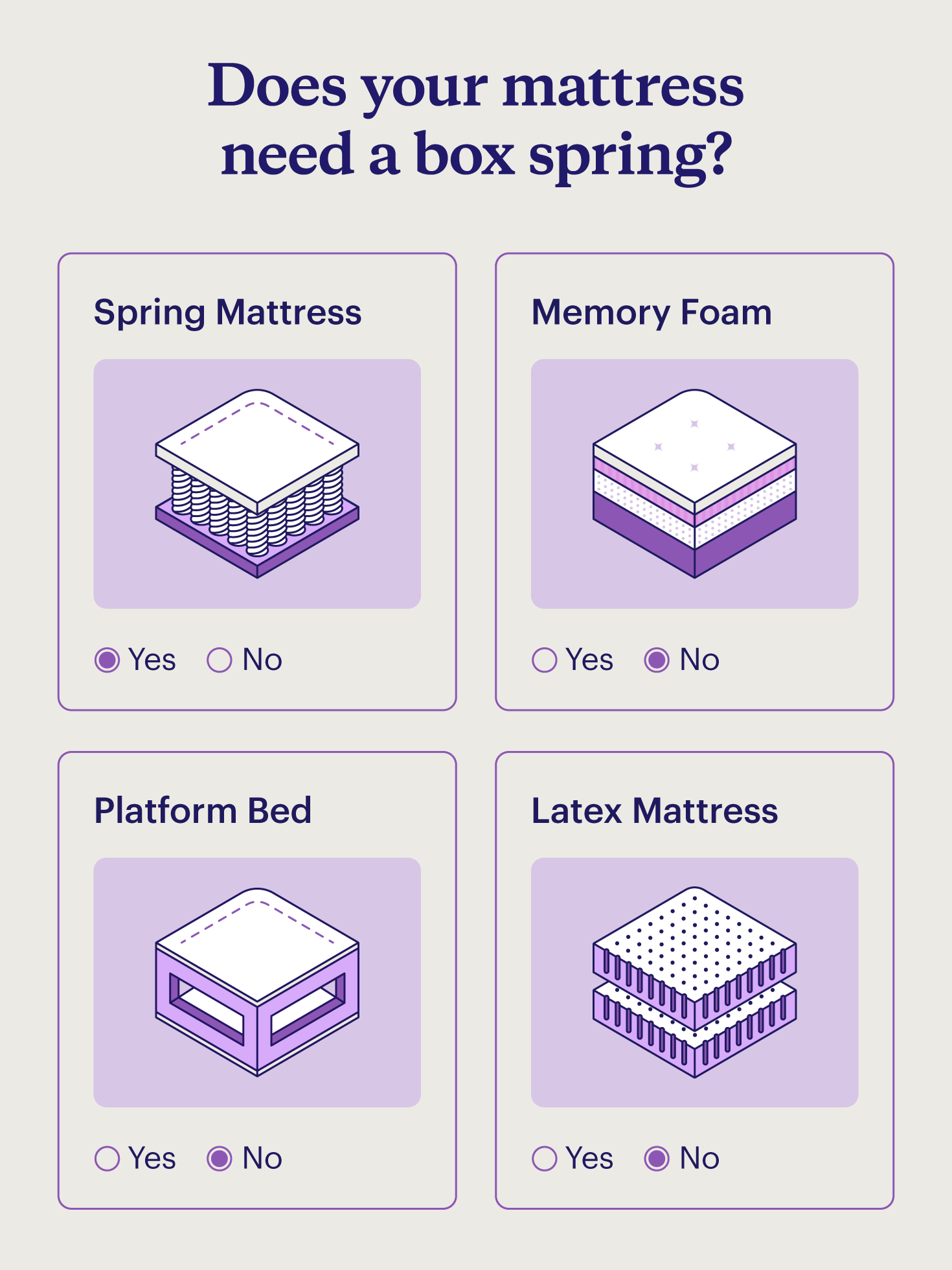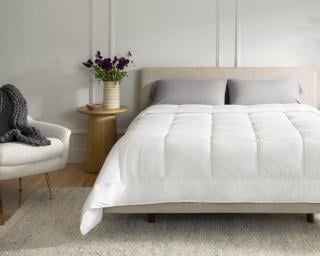
Do You Need a Box Spring? If You Have These Mattresses, Yes
Key Takeaways:
- Older mattresses frequently needed box springs, but most newer mattresses — including foam mattresses — do not require a box spring.
- Box springs provide a solid, flat surface to support a mattress and can elevate the height of your bed.
- Box springs can increase airflow and absorb shocks, but they’re also bulky and can increase motion transfer.
Having the proper support between your mattress and the floor can be crucial to getting the most support out of a mattress. Do you need a box spring with a mattress? Or is there a better alternative, like a platform bed or an adjustable bed? There are a few factors to keep in mind when considering whether you should use a box spring.
Most modern mattresses — including latex and memory foam — don’t need a box spring. However, if you have a spring mattress, you do need a box spring. Check with your mattress manufacturer to know whether a box spring is required. Your sleep preferences can also impact whether or not you need a box spring. Read more to learn about key information related to using a box spring or not.
What Is a Box Spring?
A box spring is a fabric-covered bed frame filled with springs and positioned directly under a mattress to support it. The box spring is built to be the same size as the mattress.
The metal grid of a box spring is designed to be firm yet supportive and have a little bit of bounce. This allows a mattress placed on a box spring to flex more under a sleeper’s weight. Since the box spring absorbs some of that pressure, this reduces the wear and tear on your mattress.
Some mattresses, including innerspring mattresses, require a box spring, but many do not. Check the warranty of your mattress to see if it requires one. Depending on your sleep preferences, you may also want a box spring or flat foundation if you like an elevated bed.
If you find that your mattress feels too bouncy with a box spring, you can place a piece of bunkie board between the mattress and the box spring to reduce bouncing while still retaining the support your mattress needs.
What Does a Box Spring Do?
A box spring can create a well-designed bed surface for better sleep and a longer-lasting mattress.
You can use box springs to elevate beds and prevent damage to a mattress. Many people enjoy having a lower bed height and sleeping with the mattress on the floor. If your bed's getting scratched up from being on the floor, a box spring can help protect it.
You can also use box springs to improve comfort. Whether you have a luxurious foam mattress or an affordable mattress that's been in your family for decades, sleeping without a platform can worsen your body aches. In contrast, an even flat surface can keep body pains at bay. This is especially true for side and stomach sleepers who need extra body support to maintain natural spine alignment.
Do Mattresses Come With Box Springs?
Not all mattresses come with box springs because they aren’t always necessary, but there are options for people who want a mattress and box spring combo. Bed manufacturers make box springs in most standard mattress sizes and bed frame sizes. You can purchase a box spring with a footboard or a headboard if you prefer the look of a traditional bed.
When Do You Need a Box Spring?
There are situations where you absolutely need a box spring. That includes when your frame or mattress types and warranties require one.
Different mattress and bed frame types can have different benefits, so knowing your preferences is important before deciding if you need a box spring. Here are the typical scenarios when you need a box spring.
If You Own a Spring Mattress
If you have an old innerspring mattress, you must use a box spring. Without a box spring, these mattresses can sag and deteriorate as they become exposed to wear and tear over time. A box spring provides even, flat support to protect the integrity of your mattress and provide a more comfortable sleeping arrangement.
If Your Frame Requires a Box Spring
If you use a traditional rail frame, you must add a box spring to your setup. These frames don’t support the entire mattress. Instead, they feature a small ledge that supports only the edge of the mattress or frame base, so you’ll need a box spring or slats to fully support your mattress.
The Mattress Manufacturer Requires It
Some mattress manufacturers recommend or require the use of a box spring. If you don’t use a box spring when a mattress manufacturer requires one, you can void the warranty and cause damage to your mattress.
When Don’t You Need a Box Spring?
We know how bouncy coil box springs can contribute to more restful nights, but do all mattresses need a box spring? Are there any situations when it doesn't help? The truth is that traditional box springs don't have a place in most modern bedrooms, but there's more to it than that. Learn more about when you don’t need a box spring.
If You Own a Foam or Hybrid Mattress
Modern mattresses can be pretty advanced, and latex mattresses, memory foam beds, and adjustable bases are becoming increasingly popular. For all of their advanced mattress features, including the fact that they’re easy to break in, these high-tech sleep solutions lack traditional beds' solid inner structures. This makes partnering them with box springs a terrible idea since the coils can wreck the soft surface and void most mattress warranties.
While you should pair a box spring with an innerspring mattress, hybrids and other modern options such as a hybrid mattress in a box may not be fully supported without a flat foundation or platform bed.
If you'd like some extra height, check out a few modern bed frames or box spring alternatives like bed slats. Read our handy guide about the pros and cons of bed slats versus box springs for tips and advice on choosing a good box spring alternative.
A word of warning to memory foam mattress owners: certain kinds of box spring supports can void your mattress warranty, so be sure to check that out before purchasing one.
If You Prefer a Modern Frame Design
Given the many types of foundations on the market, you shouldn’t feel pressured to fit a box spring into your sleep zone. If you prefer the flexibility of an adjustable base or the style of wood pallets, then you may want to skip box springs altogether. For hybrid mattresses, look at the best adjustable bases and other state-of-the-art bed frames for a budget-friendly choice that fits your preferred sleeping method.
If you have a platform bed and a newer frame, you don’t need a box spring. Mattress foundations with slats 3-4 inches apart don’t need a box spring. That’s because these slats provide enough support for your mattress without needing one.
If you’re looking for a good bed frame for your mattress, check out our guide to bed frames.
If You Like Sleeping Low to the Ground
If you’re the kind of person who prefers sleeping with their mattress directly on the ground, that’s totally fine. There are no hard and fast rules regarding your bedroom furniture, and box springs or bed frames aren’t necessary if you don’t want them. However, we recommend investing in a mattress protector if you’re going to sleep on the floor.
Pros of Using a Box Spring
Box springs offer several benefits for sleepers, including more height, providing support, and improving airflow. Depending on your sleep preferences, you may find that a box spring helps create better conditions for your rest. Here are the pros and cons of using a box spring.
Provides Added Height
Sleeping on a mattress directly on the floor means you might struggle when getting out of bed. Having a panel bed or platform bed foundation like a box spring can lift your mattress to a more comfortable height.
Adds Support For a Traditional Mattress
If you own an innerspring mattress, you know that sustained use results in your bed losing its shape over time. That’s because the actual springs in these mattress models are susceptible to sagging and warping caused by body weight. And when people spend an average of 36 years in bed, that means a lot of use.
A sturdy foundational layer provides a support system for your mattress to keep it from deforming. This is especially true if you have a metal frame. By adding a box spring, you can protect your mattress and prevent it from sagging and deforming.
May Improve Airflow
The lack of air circulation makes warm nights even hotter, which results in restless evenings. That's where box spring bases can help. These platform bases lift your mattress off the ground, letting heat travel and dissipate through most types of mattresses. The extra ventilation from the box spring can also help prevent mold and mildew from accumulating inside your mattress or on your covers.
Helps Absorb Shock
If you own a traditional innerspring mattress, you’ll need something to help absorb the shock of your body weight. That’s because innerspring mattresses contain metal coils to create a firm surface for sleeping, but these need extra support to be comfortable.
Cons of Using a Box Spring
In some cases, people may find that box springs aren’t as useful or practical. Pricing and budget can impact whether a box spring is a good fit for your home since some box springs can be more expensive than box spring alternatives. In addition, box springs may be too large or bulky for some rooms, and they don’t offer storage like other platform options. Here are the main cons of using a box spring.
Increase Motion Transfer
Box springs can increase motion transfer, especially as they age. These frames often have springs that can loosen over time, resulting in more movement transferring into the mattress. A bad box spring can ruin a mattress, especially if it is exceptionally old or poorly made. To reduce motion transfer, try a different mattress type that doesn’t need a box spring.
May Cause Noise
As they age, the movement of box springs can also mean they become noisier. You may hear creaking as you turn over or shift in bed. Box springs with wooden frames can also make scraping noises as they rub against the bed frame.
May Sag Over Time
Over time, box springs can start to sag with normal wear and tear. If you find your box spring isn’t as flat and firm as it once was, look into how to fix a sagging mattress or consider replacing the mattress and box spring.
Heavy and Bulky
Box springs can be bulky and not as well-suited for small rooms. Since they’re often made of metal and wood, they tend to be heavy, meaning they’re more challenging to move.
Pros | Cons |
Provides added height | Increases motion transfer |
Supports traditional mattress | May cause noise over time |
May improve airflow | May sag over time |
Helps absorb shocks | Heavy and bulky |
Box Springs vs. Other Types of Frames
As we mentioned earlier, there are plenty of foundation options on the market for all kinds of sleepers. But when it comes to looking for a box spring alternative or deciding on a box spring vs no box spring, there are really only two other options to consider: the foundation and platform bed.
Here’s how they differ.
- Foundation: As the name suggests, this is a type of foundation that provides a very sturdy surface for beds to lay on. This box spring alternative is typically made from wooden slats and pairs well with hybrid mattresses and other soft bed types. There are many different types of bed foundations — check out our handy guide to learn how to choose the right kind of bed foundation you need.
- Flat Foundation: A Flat Foundation looks like a box spring from the outside, however the inside does not have springs. It is constructed of wood or steel and usually has slats. This provides the benefits of height and support while being compatible with memory foam, latex, hybrid or gel mattresses. Great support solution for panel bed frame owners.
- Platform: A platform bed frame combines mattress support with a bed frame and usually comes with little wooden legs for a bit of lift. Some options also include extra storage space, which can be great for small spaces. However, platform beds tend to be a little pricier than other alternatives and are often mistaken for panel beds. Unlike panel beds, you don’t need a foundation or box spring to put a mattress on a platform bed. Check out our article on the differences between panel beds and platform beds to see which is right for you.
Check out our full articles where we compare box springs vs. foundations and box springs vs. platform beds to discover which one is right for your mattress type. You may also want to learn more about memory foam vs spring mattresses to choose the best foundation or platform for your needs.
Does a Purple Mattress Need a Box Spring?
The short answer is no, and there isn’t a best box spring for a Purple mattress. All Purple mattresses are top-of-the-line mattresses designed with comfort and better sleep in mind. We do not recommend using a Purple mattress on box springs, but what we do recommend is even better.
To get the most life out of your Purple mattress, we recommend pairing it with a Purple adjustable base, Purple bed frame, or other box spring alternatives. Purple bed frames are strong, easy to assemble, and create a solid base for your mattress. With a Purple bed frame, you know you’re getting the best for your Purple mattress.
Frequently Asked Questions About Box Springs
No, you don’t have to have a box spring with a mattress. Some modern mattresses, like latex and foam mattresses, don’t require a box spring, but if you want your bed to sit higher, using a foundation, platform, or adjustable base can life your mattress like a box spring would.
Consider your sleep preferences and check with the manufacturer and warranty information to determine if you need a box spring.
Depending on the type of bed frame, you may or may not be able to put a mattress directly on it. Foundations with a frame and slats are suitable for some types of mattresses. Spring mattresses paired with simple, metal bed frames must have a box spring for support.
You don’t need a box spring if you have slats because the wooden panels can support the mattress on their own. You may still want to consider a box spring depending on sleep preferences, such as when you want to add extra height to your bed.
Purple mattresses do not come with box springs. We recommend pairing your Purple mattress with a Purple bed frame to assure you get the most out of the life of your mattress. Use of a box spring may damage your Purple mattress and void the warranty.
A Purple mattress should not be used on a box spring. Use of a box spring can damage your Purple mattress and void its warranty. Instead, pair your Purple mattress with a Purple bed frame for the best possible comfort.
Yes, you can put a new mattress on top of an old box spring. However, this may not be the best idea if you want to maximize the support and longevity of your mattress. Box springs naturally deteriorate over time and, in some cases, can have exposed springs that may damage your mattress and impact your sleep quality.
Check out our guide to putting new mattresses on old box springs to see if this is a viable option for you
More to Explore
Level up your sleep routine with our most-loved products











